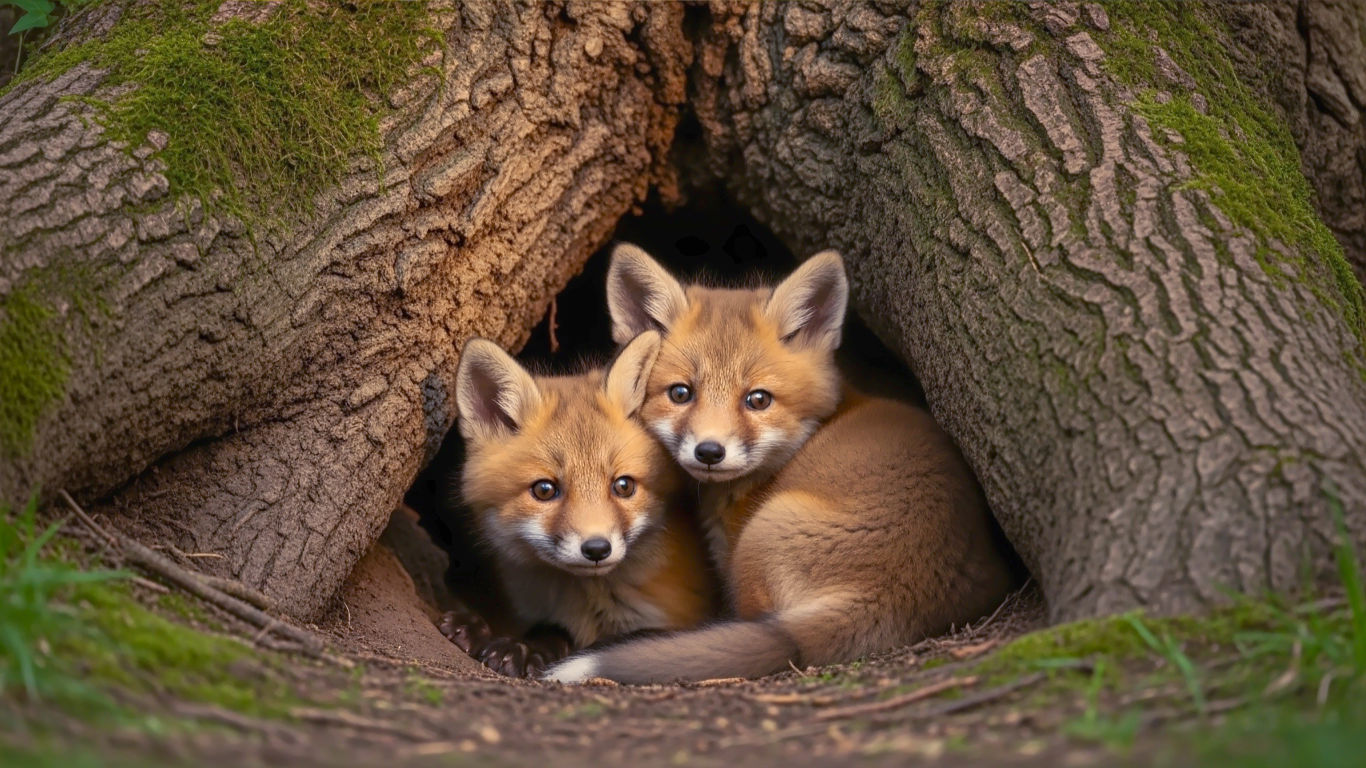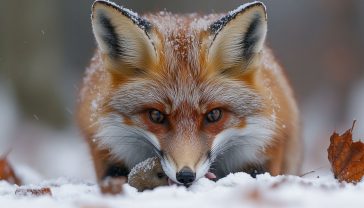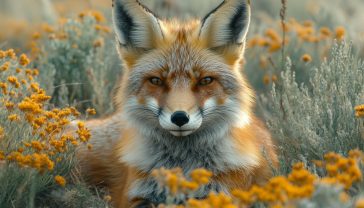What Are Baby Foxes Called? A Deep Dive Into Their Secret Early Life
Ever wondered what a baby fox is called? This guide reveals the charming names—kits, cubs, and pups—and delves into their secret world in the UK.

This post may contain affiliate links. If you make a purchase through these links, we may earn a commission at no additional cost to you.
Picture a crisp spring morning in the British countryside. The dew is still clinging to the bluebells, and a gentle mist hangs over the fields. Deep within a thicket, tucked away from sight under the roots of an old oak tree, a tiny miracle is unfolding. A flash of reddish fur, a twitch of a nose, and the faintest whimper. This is the hidden world of a baby fox.
But what do we actually call them? While you might be tempted to say “puppy,” and you wouldn’t be entirely wrong, the proper and most charming terms for a baby fox are a kit, a cub, or a pup. All three are correct, but kit is perhaps the most common among wildlife experts in the UK.
This simple question, however, opens the door to one of Britain’s most fascinating wildlife stories: the journey of a fox from a blind, helpless kit to a cunning and resourceful hunter. It’s a tale of survival, family, and play, happening right under our noses, from the rolling hills of the Cotswolds to the bustling back gardens of London.
So, let’s pull back the curtain on the secret life of a fox kit. We’ll explore how they’re born, what their first few weeks are like, how they learn to survive, and the vital roles their parents play. It’s a story that’s more complex, more touching, and more incredible than you might imagine.
The Fox Family: Vixens, Dogs, and Their Kits
Before we meet the kits themselves, it’s important to understand the family they’re born into. The world of the Red Fox (Vulpes vulpes), the only native fox species in Britain, is built around a clever and adaptable family structure.
Meet the Parents: The Vixen and the Dog Fox
A female fox is called a vixen, and a male is known as a dog fox or a tod. They typically form a monogamous pair, often staying together for life. Their bond is crucial for the survival of their offspring.
- The Vixen (The Mother): The vixen is the heart of the family. She is responsible for giving birth and nursing the kits during their most vulnerable first few weeks. She chooses and prepares the den, ensuring it’s a safe and warm nursery for her young. She rarely leaves their side initially, relying entirely on her mate to bring her food.
- The Dog Fox (The Father): The dog fox is the provider and protector. While the vixen is nursing, his primary job is to hunt tirelessly for both himself and his partner. He’ll bring back food, leaving it at the entrance of the den for her. He also plays a key role in defending their territory from rivals and predators, ensuring the area around the den is safe for his growing family.
Sometimes, a fox family might include a “helper.” This is often a female from the previous year’s litter who stays behind to help her parents raise the next generation of kits. She acts as a sort of babysitter and extra provider, increasing the chances of the new litter’s survival. This behaviour shows just how sophisticated their social lives can be.
The Den: A Fox’s Castle
The den, also known as an “earth,” is the safe haven where the kits are born and raised. It’s more than just a hole in the ground; it’s a carefully selected and often complex underground system.
Foxes don’t always dig their own dens from scratch. They are resourceful opportunists. A good den might be:
- An old, abandoned badger sett (badgers are excellent engineers, and their setts are often extensive).
- A rabbit warren that the fox has enlarged.
- A natural cavity under the roots of a large tree.
- A space beneath a garden shed, decking, or even in a railway embankment in urban areas.
A vixen will meticulously prepare the den before giving birth, clearing it out and sometimes digging new tunnels. A good den will have multiple entrances and exits, providing a quick escape route if danger approaches. The main nesting chamber is usually located deep underground, where the temperature is stable and the kits are protected from the cold, wet British weather and any potential threats. Vixens are also known to have several backup dens in their territory, and they won’t hesitate to move their entire litter if they feel their current home has been discovered or disturbed.
The First Chapter: Life as a Newborn Kit
After a gestation period of about 53 days, the vixen gives birth to her litter, usually between March and May. This is a time of incredible vulnerability, and the den is a fortress of warmth and safety against the outside world.
Birth and First Appearances
A typical litter contains four to five kits, though it can be as few as one or as many as ten. When they are born, they are incredibly tiny, weighing only about 100 grams—roughly the same as a small apple.
Newborn kits look very different from the sleek, red-coated foxes we’re used to seeing.
- Colour: They are born with a coat of dark, chocolate-brown or greyish, woolly fur. This helps them stay camouflaged in the darkness of the den. Their iconic red coat won’t start to grow in until they are a few weeks old.
- Eyes and Ears: They are born blind and deaf. Their eyes and ears are sealed shut, meaning their entire world is defined by touch, warmth, and the smell of their mother and siblings.
- Teeth: They are completely toothless. For the first couple of weeks, their only source of food is their mother’s milk.
For the first two weeks of their lives, the kits are utterly dependent. Their bodies can’t yet regulate their own temperature, so they rely on the vixen’s body heat and huddling together with their littermates to stay warm. The vixen will spend almost all her time curled around them, nursing them and keeping them clean. It’s a period of darkness, warmth, and quiet growth.
Weeks 1-2: A World of Darkness and Warmth
During this critical period, the kits do little more than feed and sleep. Their legs are weak, and they can only manage a clumsy crawl. The vixen’s milk is rich in fat and protein, designed for rapid growth. A kit’s weight can double in its first week alone.
The vixen’s dedication is absolute. She is a meticulous mother, constantly licking her kits to keep them clean and to stimulate their digestion. The dog fox, meanwhile, is on constant duty outside, hunting for voles, mice, rabbits, and birds to sustain the vixen. Without his support, the family would likely not survive.
Growing Up Fast: The Journey from Kit to Young Fox
The transformation from a tiny, helpless kit to a recognizable young fox happens astonishingly quickly. Each week brings new milestones as they develop the skills they’ll need to survive in the wild.
Weeks 2-4: The World Opens Up
This is when the magic really begins.
- Opening their Eyes: At around 10 to 14 days old, the kits’ eyes finally begin to open. At first, their vision is blurry, but it’s their first connection to the visual world. Their eyes are a striking blue colour at this stage, which will gradually change to the familiar amber or gold of an adult fox over the next couple of months.
- Hearing the World: Around the same time, their ear canals open up, and they begin to hear for the first time. The muffled sounds of their mother and the rustling of their siblings become the soundtrack to their young lives.
- First Steps: As their legs grow stronger, they start to move around the den with more confidence, wrestling and tumbling with their littermates. These clumsy play-fights are more than just fun; they are the very first lessons in coordination, strength, and social behaviour.
Weeks 4-6: First Glimpse of the Outside World
By the time they are a month old, the kits are becoming much more adventurous. They look more like miniature foxes now. Their dark baby fur is being replaced by a sandy or reddish-brown coat, and their muzzles are starting to elongate.
This is the age when they will take their first brave steps outside the den.
- Emergence: On a quiet evening, usually around dusk, the kits will begin to emerge, cautiously poking their heads out to see the world for the first time. The first to emerge is often the boldest of the litter, with its siblings soon following suit.
- A World of Wonder: The world outside the den is a sensory explosion. The feeling of grass under their paws, the scent of the evening air, the sight of the setting sun—it’s all completely new and exciting. Initially, they stay very close to the den entrance, ready to scamper back inside at the slightest sound. The vixen is always nearby, standing guard with a watchful eye.
During this period, the kits are also weaned off their mother’s milk and start eating solid food. The dog fox and vixen will begin bringing small prey back to the den. At first, they will regurgitate partially digested food for the kits, which is easier for their developing stomachs to handle. Soon after, they will bring whole items like mice or voles for the kits to practice their hunting skills on.
Play: The Most Important Lesson
For the next two months, the lives of the fox kits are dominated by play. This is not just frivolous fun; it’s the fox equivalent of school, and it’s essential for their development.
Through play, they learn a huge range of vital skills:
- Hunting Techniques: They will pounce on insects, leaves, and even their siblings’ tails. This “mouse pounce”—leaping high into the air and bringing their front paws down on their target—is a classic fox hunting move they will use to catch rodents hidden in long grass as adults.
- Social Hierarchy: Through wrestling and mock-fights, they establish a pecking order within the litter. They learn to understand body language, submission, and dominance. The strongest, most assertive kit often gets the most food and learns to be a leader.
- Fighting and Defence: Their play-fights teach them how to bite without causing serious injury, how to dodge, and how to use their agility. These are skills that will be crucial for defending territory and dealing with rivals when they are older.
- Exploration and Agility: They will chase each other around, tumbling over logs and racing through undergrowth. This builds their stamina, coordination, and knowledge of the local terrain.
The parents often join in, teaching the kits through example. The vixen might bring a wounded mouse back to the den and release it, allowing the kits to practice their catching and killing techniques in a controlled environment.
Learning to be a Fox: Foraging and First Hunts
As summer progresses, the kits become more independent. They start to look like small, slightly lanky versions of their parents. Their coats are now a rich red, and their tails—or brushes—are becoming thick and bushy.
Accompanying the Parents
From around 10 to 12 weeks old, the kits will begin to follow their parents on their first proper foraging trips. These are no longer just playful excursions around the den; they are serious lessons in survival.
They learn by watching and mimicking their parents:
- Finding Food: They discover that food can be found everywhere. They learn to dig for earthworms and beetles, raid fruit bushes for berries, and scavenge for discarded food in urban areas. Foxes have an incredibly varied diet, and this is when the kits learn what’s good to eat and where to find it.
- Hunting Skills: They watch their parents stalk prey, learning the importance of stealth, patience, and the element of surprise. The dog fox might show them how to listen for the rustle of a vole in the grass or how to track the scent of a rabbit.
- Recognising Danger: Crucially, they learn to identify threats. The sharp alarm bark of a parent will send them scurrying for cover instantly. They learn the silhouettes of birds of prey and the scent of badgers or rival foxes.
The Urban Fox Kit
For the many foxes living in Britain’s towns and cities, the lessons are slightly different. An urban fox kit learns a different set of skills.
- Navigating the Streets: They learn the rhythm of the city—when the streets are quietest and which gardens are the safest. They master the art of crossing roads, a major danger for urban wildlife.
- Scavenging: They are taught how to find food left out by humans. They might learn which houses leave out food for birds (or even for the foxes themselves), where the bins are likely to be overflowing, and how to get into a compost heap.
- Human Interaction: They learn that humans are a source of both food and danger. They become experts at staying in the shadows, moving unseen through gardens and alleyways.
This incredible adaptability is the secret to the Red Fox’s success across Britain, from the most remote parts of the Scottish Highlands to the very centre of London.
Leaving Home: Dispersal and Independence
By the time late summer and autumn arrive, the fox family begins to break up. The kits are now almost fully grown and are known as juveniles. The easy days of play are over, and the serious business of finding their own way in the world begins.
The Time to Leave
Between six and eight months old, the young foxes must leave their parents’ territory to find their own. This process is called dispersal. It is a natural and necessary part of the fox life cycle, preventing overpopulation and inbreeding.
It’s a difficult and dangerous time for a young fox. They are driven out by their parents, who will become increasingly aggressive towards them to encourage them to leave. The young dog foxes are usually the first to go and tend to travel further than their sisters. A young vixen may stay within or near her parents’ territory, sometimes even becoming one of the “helpers” for the next year’s litter.
The Perils of a Young Fox
The first year of a fox’s life is by far the most perilous. During dispersal, they face numerous challenges:
- Finding Territory: They must find an unoccupied patch of land with enough food and a suitable place for a den. This often involves clashing with other, more established adult foxes who will fiercely defend their own territories.
- Starvation: They are no longer being fed by their parents and must rely entirely on their own hunting and scavenging skills. An inexperienced young fox can easily struggle to find enough food, especially during a harsh winter.
- Roads and Humans: In both rural and urban areas, roads are one of the biggest killers of young foxes. They are also vulnerable to persecution and disturbance from humans.
- Disease: Diseases like sarcoptic mange can be devastating for a young fox whose immune system may be weakened by the stress of dispersal.
Sadly, it is estimated that more than half of all fox kits do not survive to see their first birthday. But those that do are the toughest, the cleverest, and the most adaptable. They will go on to find a mate, establish their own territory, and, in the following spring, start the cycle all over again with a new litter of their own tiny, blind, and utterly dependent kits.
A Final Thought: The Resilience of the Fox
The story of a fox kit is a powerful reminder of the drama of the natural world that unfolds all around us. From the moment it is born—a tiny, helpless kit—to the day it leaves home as a resourceful juvenile, its life is a masterclass in survival.
So, the next time you catch a fleeting glimpse of a fox slipping across a field at dusk or trotting down a suburban street in the dead of night, remember the incredible journey it has undertaken. Remember the vixen who nursed it, the dog fox who fed it, and the hidden den where it first opened its eyes to the world. It’s a story of family, resilience, and the enduring wild spirit that thrives right here in the heart of Britain.
Further Reading
For those interested in learning more about British wildlife and fox conservation, these resources are highly recommended:
- The Wildlife Trusts: A leading conservation charity in the UK, with fantastic resources on native species. https://www.wildlifetrusts.org/wildlife-explorer/mammals/red-fox
- The RSPCA (Royal Society for the Prevention of Cruelty to Animals): Offers advice on living alongside urban foxes and what to do if you find an injured or orphaned animal. https://www.rspca.org.uk/adviceandwelfare/wildlife/foxes
- The Fox Project: A charity dedicated to the protection, rescue, and advocacy of the Red Fox. https://foxproject.org.uk/
- BBC Wildlife Magazine: An excellent source for in-depth articles and stunning photography of British wildlife. https://www.discoverwildlife.com/






